Related Research Articles

Kazimierz Józef Marian Michałowski was a Polish archaeologist and Egyptologist, art historian, member of the Polish Academy of Sciences, professor ordinarius of the University of Warsaw as well as the founder of the Polish school of Mediterranean archaeology and a precursor of Nubiology.
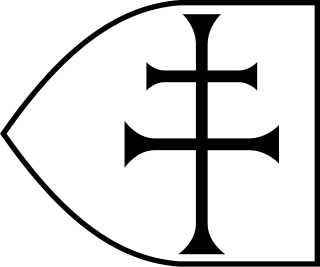
Makuria was a medieval Nubian kingdom in what is today northern Sudan and southern Egypt. Its capital was Dongola in the fertile Dongola Reach, and the kingdom is sometimes known by the name of its capital.
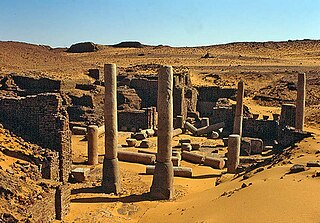
Old Dongola is a deserted town in what is now Northern State, Sudan, located on the east bank of the Nile opposite the Wadi Howar. An important city in medieval Nubia, and the departure point for caravans west to Darfur and Kordofan, from the fourth to the fourteenth century Old Dongola was the capital of the Makurian state. A Polish archaeological team has been excavating the town since 1964.

Soba is an archaeological site and former town in what is now central Sudan. Three kingdoms existed in medieval Nubia: Nobadia with the capital in Faras, Makuria with the capital in Dongola, and Alodia (Alwa) with the capital in Soba. The latter used to be the capital of the medieval Nubian kingdom of Alodia from the sixth century until around 1500. E. A. Wallis Budge identified it with a group of ruins on the Blue Nile 19 kilometres (12 mi) from Khartoum, where there are remains of a Meroitic temple that had been converted into a Christian church.

Faras was a major city in Lower Nubia. The site of the city, on the border between modern Egypt and Sudan at Wadi Halfa Salient, was flooded by Lake Nasser in the 1960s and is now permanently underwater. Before this flooding, extensive archaeological work was conducted by a Polish archaeological team led by professor Kazimierz Michałowski.

Nobatia or Nobadia was a late antique kingdom in Lower Nubia. Together with the two other Nubian kingdoms, Makuria and Alodia, it succeeded the kingdom of Kush. After its establishment in around 400, Nobadia gradually expanded by defeating the Blemmyes in the north and incorporating the territory between the second and third Nile cataract in the south. In 543, it converted to Coptic Christianity. It would then be annexed by Makuria, under unknown circumstances, during the 7th century.

Nubia is a region along the Nile river encompassing the area between the first cataract of the Nile and the confluence of the Blue and White Niles, or more strictly, Al Dabbah. It was the seat of one of the earliest civilizations of ancient Africa, the Kerma culture, which lasted from around 2500 BC until its conquest by the New Kingdom of Egypt under Pharaoh Thutmose I around 1500 BC, whose heirs ruled most of Nubia for the next 400 years. Nubia was home to several empires, most prominently the Kingdom of Kush, which conquered Egypt in the eighth century BC during the reign of Piye and ruled the country as its 25th Dynasty.

Banganarti is a small village in Sudan, about half way between the third and fourth cataract of the Nile. It is situated 10 kilometres (6.2 mi) from Old Dongola, the capital of Makuria. Banganarti was an important Christian pilgrim center; the remains of a substantial medieval church are near the village (18.166736,30.784785).
Jack MartinPlumley, was a British Anglican priest, Egyptologist and academic. Having served as a priest in the Church of England, he was Sir Herbert Thompson Professor of Egyptology at the University of Cambridge from 1957 to 1977.
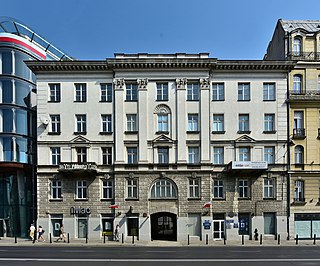
The Polish Centre of Mediterranean Archaeology University of Warsaw operates as an independent research institute of the University of Warsaw under the present name since 1990. It is dedicated to organizing, implementing and coordinating archaeological research, both excavations and study projects, as well as conservation, reconstruction and restoration projects, in northeastern Africa, the Near East and Cyprus. Projects include sites covering a broad chronological spectrum from the dawn of civilization through all the historic periods of the ancient Mediterranean civilizations to Late Antiquity and early Islam. Tasks beside fieldwork include comprehensive documentation of finds, archives management and publication of the results in keeping with international research standards. The PCMA manages the Research Centre in Cairo and Polish Archaeological Unit in Khartoum.
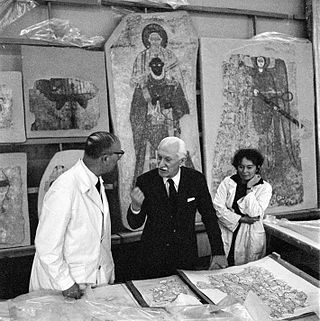
Józef Gazy (1910–1998) was a Polish artist, sculptor and restorer. Author of several monuments set in public space in various cities in Poland. In the 1960s he served as the leader of a team responsible for removal, maintenance, conservation and restoration of frescoes from the cathedral of Faras.
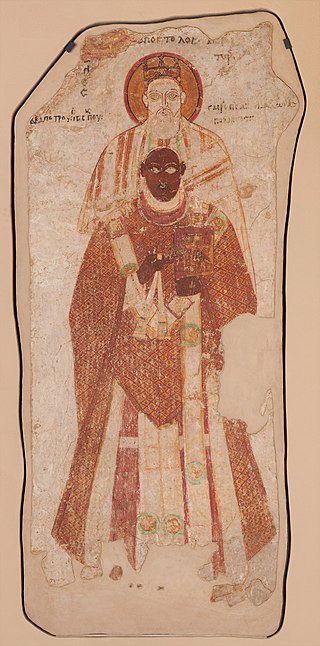
Bishop Petros with Saint Peter the Apostle is a Nubian Christian wall painting from the last quarter of the 10th century. Made with tempera on silt plaster using an al secco fresco technique, it depicts Petros, the bishop of Faras between 974 and 997. The anonymous work was discovered in the ruins of Faras Cathedral, an important religious centre of Nubia, in modern Sudan. Rescued from flooding when Lake Nasser was created, since 1964 it is part of the Faras Gallery of the National Museum in Warsaw.

Saint Anne is a Makurian wall painting estimated to have been painted between the 8th and 9th centuries, painted al secco with tempera on plaster. The anonymous work was found at the Faras Cathedral within old Nubia in Faras Wadi Halfa present-day Sudan.

Faras Cathedral was a cathedral in the Lower Nubian city of Faras. It was the original seat of the Diocese of Faras.

The Professor Kazimierz Michałowski Faras Gallery at the National Museum in Warsaw is a permanent gallery at the National Museum in Warsaw, presenting Nubian early Christian art. The Gallery features a unique collection of wall paintings and architectural elements from the Faras Cathedral, discovered by an archeological expedition led by Professor Kazimierz Michałowski.

The Research Centre in Cairo, Polish Centre of Mediterranean Archaeology University of Warsaw, is the only Polish scientific research institution in Africa and the Middle East, where it has operated since 1959 in Cairo. The mission of the Research Centre is to develop and expand Polish research in the region, particularly in the Nile Valley. It is operated by the Polish Centre of Mediterranean Archaeology, an independent research institute of the University of Warsaw. The PCMA Cairo Research Centre is located in two buildings situated in close proximity to one another in the Cairo Heliopolis district — in antiquity the centre of a religious cult and the location of the Egypt's reputedly largest temple.

The Throne Hall of Dongola, also known as the Mosque Building, is an archaeological site in Old Dongola, Sudan. It is a two-storey brick building situated on a rocky hill, overlooking the town and the Nile valley. It was originally built in the 9th century, serving as the richly adorned representative building of the Makurian kings. In 1317, during the period of Makurian decline, it was converted into a mosque, serving this purpose until it was closed and turned into a historic monument in 1969. Shortly afterwards Polish archaeologists from the Polish Centre of Mediterranean Archaeology of the University of Warsaw began to excavate the building. It has been described as possibly "the most important, symbolic edifice in the medieval history of Sudan". It is presently the oldest preserved mosque in Sudan.

The Dongola Reach is a reach of approximately 160 km in length stretching from the Fourth downriver to the Third Cataracts of the Nile in Upper Nubia, Sudan. Named after the Sudanese town of Dongola which dominates this part of the river, the reach was the heart of ancient Nubia.
Jadwiga Lipińska née Freyer was a Polish Egyptologist.

Faculty of Archaeology, University of Warsaw (WAUW) is a faculty of the University of Warsaw, established on September 1, 2020, through the transformation of the Institute of Archaeology, which operated as part of the now-defunct Faculty of History. The Faculty is based in the Szkoła Główna Warszawska building. It is the largest archaeological institution in Poland, comprises 17 departments and 7 laboratories with a staff of about 100. The Faculty provides education in various branches of modern archaeology and related sciences to over 1500 students from various fields of study: Ancient Egypt, Ancient America, Classical Archaeology, and Ancient Near East. The Archaeology program at the University of Warsaw is placed between 51st and 100th worldwide in Quacquarelli Symonds World University Ranking (QS)
References
- ↑ Górzyński, Maciej (2014). Gawedy o Malachowiakach. Towarzystwo Wychowanków, Wychowawców i Przyjaciół Gimnazjum I Liceum im. St. Małachowskiego w Płocku. ISBN 978-83-9223-318-3.
- 1 2 Michałowski, Kazimierz (1974). Od Edfu do Faras. Wydawnictwa Artystyczne i Filmowe. pp. 258–259.
- 1 2 3 "Stara Dongola". www.zaspan.waw.pl. Archived from the original on August 17, 2016. Retrieved September 26, 2016.
- ↑ "Dongola". pcma.uw.edu.pl. Retrieved July 18, 2020.
- 1 2 "Stefan Jakobielski, PhD, Dr habil". www.iksiopan.pl. Retrieved July 18, 2020.
- ↑ ""W pustyni i w słońcu. Polskie wykopaliska w Starej Dongoli" | Wydarzenie | Culture.pl" . Retrieved September 26, 2016.
- ↑ "Stefan Jakobielski, PhD, Dr habil". www.iksiopan.pl. Archived from the original on March 13, 2023. Retrieved March 13, 2023.